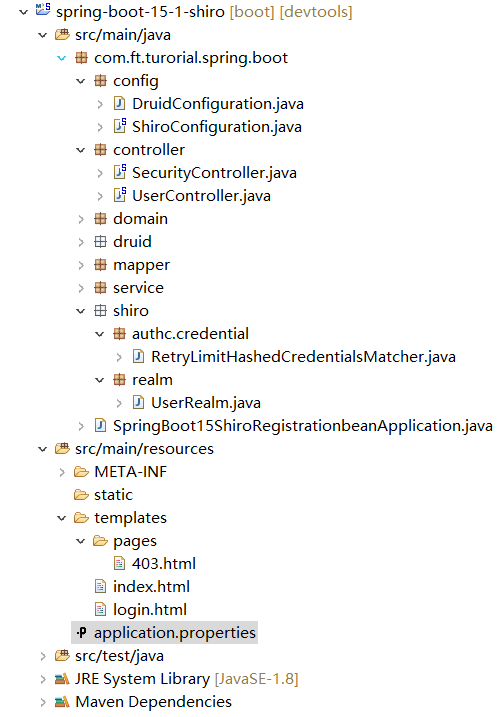Apache Shiro是Java的一个安全框架。目前,使用Apache Shiro的人越来越多,因为它相当简单,对比Spring Security,可能没有Spring Security做的功能强大,但是在实际工作时可能并不需要那么复杂的东西,所以使用小而简单的Shiro就足够了。
详细基础知识,请参考跟我学Shiro 的系列文章
这里只是给出Spring Boot 集成Shiro 的案例,Spring Boot就是为了简化传统Spring开发的复杂度,即去xml化,所以案例中也是没有xml配置,完全 javaconfig方式配置。
集成Shiro核心内容:
- ShiroFilterFactory,Shiro过滤器工程类,具体的实现类是:ShiroFilterFactoryBean,此实现类是依赖于SecurityManager安全管理器。主要配置Filter就好。
- SecurityManager,Shiro的安全管理,主要是身份认证的管理,缓存管理,cookie管理,所以在实际开发中我们主要是和SecurityManager进行打交道的。
- Realm,用于身份信息权限信息的验证。开发时集成AuthorizingRealm,重写两个方法:doGetAuthenticationInfo(获取即将需要认真的信息)、doGetAuthorizationInfo(获取通过认证后的权限信息)。
- HashedCredentialsMatcher,凭证匹配器,用于告诉Shiro在认证时通过什么方式(算法)来匹配密码。默认(storedCredentialsHexEncoded=false)Base64编码,可以修改为(storedCredentialsHexEncoded=true)Hex编码。
- LifecycleBeanPostProcessor,Shiro生命周期处理器,保证实现了Shiro内部lifecycle函数的bean执行。
- 开启Shiro的注解功能(如@RequiresRoles,@RequiresPermissions),需借助SpringAOP扫描使用Shiro注解的类,并在必要时进行安全逻辑验证,需要配置两个bean(DefaultAdvisorAutoProxyCreator(可选)和AuthorizationAttributeSourceAdvisor)实现此功能。
- 其它的就是缓存管理,记住登录、验证码、分布式系统共享Session之类的,这些大部分都是需要自己进行的实现,其中缓存管理,记住登录比较简单实现,并需要注入到SecurityManager让Shiro的安全管理器进行管理就好了。后续章节中会一 一补充。
下面使用Spring Boot 集成Shiro完成一个比较简单的安全验证(传统XML方式配置,请点击这里):
步骤1:首先创建一个Maven工程,在pom.xml中添加shiro相关依赖包:
<!-- 在Spring Boot中使用Thymeleaf模板引擎 -->
<dependency>
<groupId>org.springframework.boot</groupId>
<artifactId>spring-boot-starter-thymeleaf</artifactId>
</dependency>
<!-- 使用Shiro认证 -->
<dependency>
<groupId>org.apache.shiro</groupId>
<artifactId>shiro-spring</artifactId>
<version>1.2.5</version>
</dependency>
<!-- 在Thymeleaf模板引擎中集成Shiro -->
<dependency>
<groupId>com.github.theborakompanioni</groupId>
<artifactId>thymeleaf-extras-shiro</artifactId>
<version>1.2.1</version>
</dependency>目录结构图(其中RetryLimitHashedCredentialsMatcher.java在本例中为使用):

步骤2:实现用户、角色的CRUD的相关类(domain,dao/mapper/repository,service),由于篇幅和重要点关系,这些就省略了。
步骤3:实现Realm,继承AuthorizingRealm,并重写doGetAuthorizationInfo(用于获取认证成功后的角色、权限等信息) 和 doGetAuthenticationInfo(验证当前登录的Subject)方法
public class UserRealm extends AuthorizingRealm{
@Resource
private UserService userService;
@Resource
private RoleService roleService;
@Override
protected AuthorizationInfo doGetAuthorizationInfo(PrincipalCollection principals) {
String currentLoginName = (String)principals.getPrimaryPrincipal();
List<String> userRoles = new ArrayList<String>();
List<String> userPermissions = new ArrayList<String>();
//从数据库中获取当前登录用户的详细信息
User user = userService.findByLoginName(currentLoginName);
if(null != user){
//获取当前用户下所有ACL权限列表 待续。。。
//获取当前用户下拥有的所有角色列表
List<Role> roles = roleService.findByUserId(user.getId());
for (int i = 0; i < roles.size(); i++) {
userRoles.add(roles.get(i).getCode());
}
}else{
throw new AuthorizationException();
}
System.out.println("#######获取角色:"+userRoles);
System.out.println("#######获取权限:"+userPermissions);
//为当前用户设置角色和权限
SimpleAuthorizationInfo authorizationInfo = new SimpleAuthorizationInfo();
authorizationInfo.addRoles(userRoles);
authorizationInfo.addStringPermissions(userPermissions);
return authorizationInfo;
}
/**
* 验证当前登录的Subject
* LoginController.login()方法中执行Subject.login()时 执行此方法
*/
@Override
protected AuthenticationInfo doGetAuthenticationInfo(
AuthenticationToken authcToken) throws AuthenticationException {
System.out.println("###【开始认证[SessionId]】"+SecurityUtils.getSubject().getSession().getId());
String loginName = (String)authcToken.getPrincipal();
User user = userService.findByLoginName(loginName);
if(user == null) {
throw new UnknownAccountException();//没找到帐号
}
//交给AuthenticatingRealm使用CredentialsMatcher进行密码匹配,如果觉得人家的不好可以自定义实现
SimpleAuthenticationInfo authenticationInfo = new SimpleAuthenticationInfo(
user.getUserName(), //用户名
user.getPassword(), //密码
ByteSource.Util.bytes(user.getCredentialsSalt()),//salt=username+salt,采用明文访问时,不需要此句
getName() //realm name
);
return authenticationInfo;
}
}步骤4:创建Shiro配置类:ShiroConfiguration,这是最重要的,用于替代XML配置的Java Config,详细说明,请看代码中注释。
@Configuration
public class ShiroConfiguration {
private static final Logger logger = LoggerFactory.getLogger(ShiroConfiguration.class);
/**
* Shiro的Web过滤器Factory 命名:shiroFilter<br />
*
* @param securityManager
* @return
*/
@Bean(name = "shiroFilter")
public ShiroFilterFactoryBean shiroFilterFactoryBean(SecurityManager securityManager) {
logger.info("注入Shiro的Web过滤器-->shiroFilter", ShiroFilterFactoryBean.class);
ShiroFilterFactoryBean shiroFilterFactoryBean = new ShiroFilterFactoryBean();
//Shiro的核心安全接口,这个属性是必须的
shiroFilterFactoryBean.setSecurityManager(securityManager);
//要求登录时的链接(可根据项目的URL进行替换),非必须的属性,默认会自动寻找Web工程根目录下的"/login.jsp"页面
shiroFilterFactoryBean.setLoginUrl("/login");
//登录成功后要跳转的连接,逻辑也可以自定义,例如返回上次请求的页面
shiroFilterFactoryBean.setSuccessUrl("/index");
//用户访问未对其授权的资源时,所显示的连接
shiroFilterFactoryBean.setUnauthorizedUrl("/pages/403");
/*定义shiro过滤器,例如实现自定义的FormAuthenticationFilter,需要继承FormAuthenticationFilter
**本例中暂不自定义实现,在下一节实现验证码的例子中体现
*/
/*定义shiro过滤链 Map结构
* Map中key(xml中是指value值)的第一个'/'代表的路径是相对于HttpServletRequest.getContextPath()的值来的
* anon:它对应的过滤器里面是空的,什么都没做,这里.do和.jsp后面的*表示参数,比方说login.jsp?main这种
* authc:该过滤器下的页面必须验证后才能访问,它是Shiro内置的一个拦截器org.apache.shiro.web.filter.authc.FormAuthenticationFilter
*/
Map<String, String> filterChainDefinitionMap = new LinkedHashMap<String, String>();
// 配置退出过滤器,其中的具体的退出代码Shiro已经替我们实现了
filterChainDefinitionMap.put("/logout", "logout");
// <!-- 过滤链定义,从上向下顺序执行,一般将 /**放在最为下边 -->:这是一个坑呢,一不小心代码就不好使了;
// <!-- authc:所有url都必须认证通过才可以访问; anon:所有url都都可以匿名访问-->
filterChainDefinitionMap.put("/webui/**", "anon");
filterChainDefinitionMap.put("/webjars/**", "anon");
filterChainDefinitionMap.put("/login", "anon");
filterChainDefinitionMap.put("/**", "authc");
shiroFilterFactoryBean.setFilterChainDefinitionMap(filterChainDefinitionMap);
return shiroFilterFactoryBean;
}
/**
* 不指定名字的话,自动创建一个方法名第一个字母小写的bean
* @Bean(name = "securityManager")
* @return
*/
@Bean
public SecurityManager securityManager() {
logger.info("注入Shiro的Web过滤器-->securityManager", ShiroFilterFactoryBean.class);
DefaultWebSecurityManager securityManager = new DefaultWebSecurityManager();
securityManager.setRealm(userRealm());
return securityManager;
}
/**
* Shiro Realm 继承自AuthorizingRealm的自定义Realm,即指定Shiro验证用户登录的类为自定义的
*
* @param cacheManager
* @return
*/
@Bean
public UserRealm userRealm() {
UserRealm userRealm = new UserRealm();
//告诉realm,使用credentialsMatcher加密算法类来验证密文
userRealm.setCredentialsMatcher(hashedCredentialsMatcher());
userRealm.setCachingEnabled(false);
return userRealm;
}
/**
* 凭证匹配器
* (由于我们的密码校验交给Shiro的SimpleAuthenticationInfo进行处理了
* 所以我们需要修改下doGetAuthenticationInfo中的代码;
* )
* 可以扩展凭证匹配器,实现 输入密码错误次数后锁定等功能,下一次
* @return
*/
@Bean(name="credentialsMatcher")
public HashedCredentialsMatcher hashedCredentialsMatcher(){
HashedCredentialsMatcher hashedCredentialsMatcher = new HashedCredentialsMatcher();
hashedCredentialsMatcher.setHashAlgorithmName("md5");//散列算法:这里使用MD5算法;
hashedCredentialsMatcher.setHashIterations(2);//散列的次数,比如散列两次,相当于 md5(md5(""));
//storedCredentialsHexEncoded默认是true,此时用的是密码加密用的是Hex编码;false时用Base64编码
hashedCredentialsMatcher.setStoredCredentialsHexEncoded(true);
return hashedCredentialsMatcher;
}
/**
* Shiro生命周期处理器
* @return
*/
@Bean
public LifecycleBeanPostProcessor lifecycleBeanPostProcessor(){
return new LifecycleBeanPostProcessor();
}
/**
* 开启Shiro的注解(如@RequiresRoles,@RequiresPermissions),需借助SpringAOP扫描使用Shiro注解的类,并在必要时进行安全逻辑验证
* 配置以下两个bean(DefaultAdvisorAutoProxyCreator(可选)和AuthorizationAttributeSourceAdvisor)即可实现此功能
* @return
*/
@Bean
@DependsOn({"lifecycleBeanPostProcessor"})
public DefaultAdvisorAutoProxyCreator advisorAutoProxyCreator(){
DefaultAdvisorAutoProxyCreator advisorAutoProxyCreator = new DefaultAdvisorAutoProxyCreator();
advisorAutoProxyCreator.setProxyTargetClass(true);
return advisorAutoProxyCreator;
}
@Bean
public AuthorizationAttributeSourceAdvisor authorizationAttributeSourceAdvisor(){
AuthorizationAttributeSourceAdvisor authorizationAttributeSourceAdvisor = new AuthorizationAttributeSourceAdvisor();
authorizationAttributeSourceAdvisor.setSecurityManager(securityManager());
return authorizationAttributeSourceAdvisor;
}
/**
* 添加ShiroDialect 为了在thymeleaf里使用shiro的标签的bean
* @return
*/
@Bean(name = "shiroDialect")
public ShiroDialect shiroDialect(){
return new ShiroDialect();
}
}步骤四5:实现Controller,登录/退出等操作。
@Controller
public class SecurityController {
private static final Logger logger = LoggerFactory.getLogger(UserController.class);
@RequiresRoles("ADMIN")
@RequestMapping(value="/index",method=RequestMethod.GET)
public String index(Model model){
String userName = (String) SecurityUtils.getSubject().getPrincipal();
model.addAttribute("username", userName);
return "index";
}
@RequestMapping(value="",method=RequestMethod.GET)
public String defaultIndex(Model model){
String userName = (String) SecurityUtils.getSubject().getPrincipal();
model.addAttribute("username", userName);
return "index";
}
@RequestMapping(value="/login",method=RequestMethod.GET)
public String loginForm(Model model){
model.addAttribute("user", new User());
return "login";
}
@RequestMapping(value="/login",method=RequestMethod.POST)
public String login(@Valid User user,BindingResult bindingResult,RedirectAttributes redirectAttributes){
if(bindingResult.hasErrors()){
return "login";
}
String username = user.getUserName();
System.out.println(username);
UsernamePasswordToken token = new UsernamePasswordToken(user.getUserName(), user.getPassword());
//获取当前的Subject
Subject currentUser = SecurityUtils.getSubject();
try {
//在调用了login方法后,SecurityManager会收到AuthenticationToken,并将其发送给已配置的Realm执行必须的认证检查
//每个Realm都能在必要时对提交的AuthenticationTokens作出反应
//所以这一步在调用login(token)方法时,它会走到MyRealm.doGetAuthenticationInfo()方法中,具体验证方式详见此方法
logger.info("对用户[" + username + "]进行登录验证..验证开始");
currentUser.login(token);
logger.info("对用户[" + username + "]进行登录验证..验证通过");
}catch(UnknownAccountException uae){
logger.info("对用户[" + username + "]进行登录验证..验证未通过,未知账户");
redirectAttributes.addFlashAttribute("message", "未知账户");
}catch(IncorrectCredentialsException ice){
logger.info("对用户[" + username + "]进行登录验证..验证未通过,错误的凭证");
redirectAttributes.addFlashAttribute("message", "密码不正确");
}catch(LockedAccountException lae){
logger.info("对用户[" + username + "]进行登录验证..验证未通过,账户已锁定");
redirectAttributes.addFlashAttribute("message", "账户已锁定");
}catch(ExcessiveAttemptsException eae){
logger.info("对用户[" + username + "]进行登录验证..验证未通过,错误次数过多");
redirectAttributes.addFlashAttribute("message", "用户名或密码错误次数过多");
}catch(AuthenticationException ae){
//通过处理Shiro的运行时AuthenticationException就可以控制用户登录失败或密码错误时的情景
logger.info("对用户[" + username + "]进行登录验证..验证未通过,堆栈轨迹如下");
ae.printStackTrace();
redirectAttributes.addFlashAttribute("message", "用户名或密码不正确");
}
//验证是否登录成功
if(currentUser.isAuthenticated()){
logger.info("用户[" + username + "]登录认证通过(这里可以进行一些认证通过后的一些系统参数初始化操作)");
return "/index";
}else{
token.clear();
return "redirect:/login";
}
}
@RequestMapping(value="/logout",method=RequestMethod.GET)
public String logout(RedirectAttributes redirectAttributes ){
//使用权限管理工具进行用户的退出,跳出登录,给出提示信息
SecurityUtils.getSubject().logout();
redirectAttributes.addFlashAttribute("message", "您已安全退出");
return "redirect:/login";
}
@RequestMapping("/pages/403")
public String unauthorizedRole(){
logger.info("------没有权限-------");
return "pages/403";
}
}步骤6:前端页面,采用Thymeleaf引擎(包括后续章节,都是采用此引擎)
login.html:
<!DOCTYPE html>
<html xmlns:th="http://www.thymeleaf.org">
<head>
<meta charset="UTF-8" />
<title>用户登录</title>
<link rel="stylesheet" type="text/css" media="all"
href="/webjars/bootstrap/css/bootstrap.min.css" th:href="@{/webjars/bootstrap/css/bootstrap.min.css}" />
<style>
body{
margin-left:auto;
margin-right:auto;
margin-TOP:100PX;
width:20em;
}
</style>
</head>
<body>
<form th:action="@{/login}" method="POST">
<!--下面是用户名输入框-->
<div class="input-group">
<span class="input-group-addon" id="basic-addon1">@</span>
<input id="userName" name="userName" type="text" class="form-control" placeholder="用户名" aria-describedby="basic-addon1" />
</div>
<br />
<!--下面是密码输入框-->
<div class="input-group">
<span class="input-group-addon" id="basic-addon1">@</span>
<input id="password" name="password" type="text" class="form-control" placeholder="密码" aria-describedby="basic-addon1" />
</div>
<br />
<!--下面是登陆按钮,包括颜色控制-->
<button type="submit" style="width:280px;" class="btn btn-default">登 录</button>
</form>
<script th:src="@{/webjars/jquery/jquery.min.js}"></script>
<script th:src="@{/webjars/bootstrap/js/bootstrap.min.js}"></script>
</body>
</html>index.html:
<!DOCTYPE html>
<html xmlns:th="http://www.thymeleaf.org">
<head>
<meta charset="UTF-8" />
<title>首页</title>
</head>
<body>
Hello, <shiro:principal/>, how are you today?
<shiro:hasRole name="ADMIN">
<br />I'm fine, 我拥有管理员角色--<span th:text="${username}"></span>
</shiro:hasRole>
</body>
</html>403.html:
<!DOCTYPE html>
<html>
<head>
<meta charset="UTF-8" />
<title>Insert title here</title>
</head>
<body>
您所访问的资源未被授权..
</body>
</html>步骤7:启动应用,在浏览器中输入 http://localhost:8080:

























 468
468

 被折叠的 条评论
为什么被折叠?
被折叠的 条评论
为什么被折叠?








